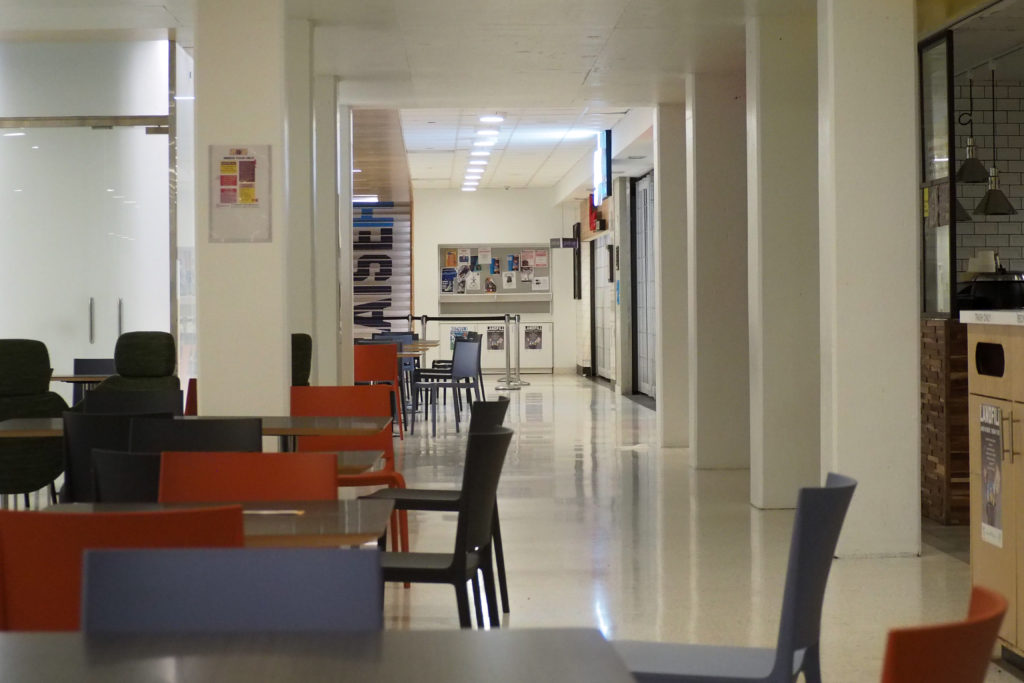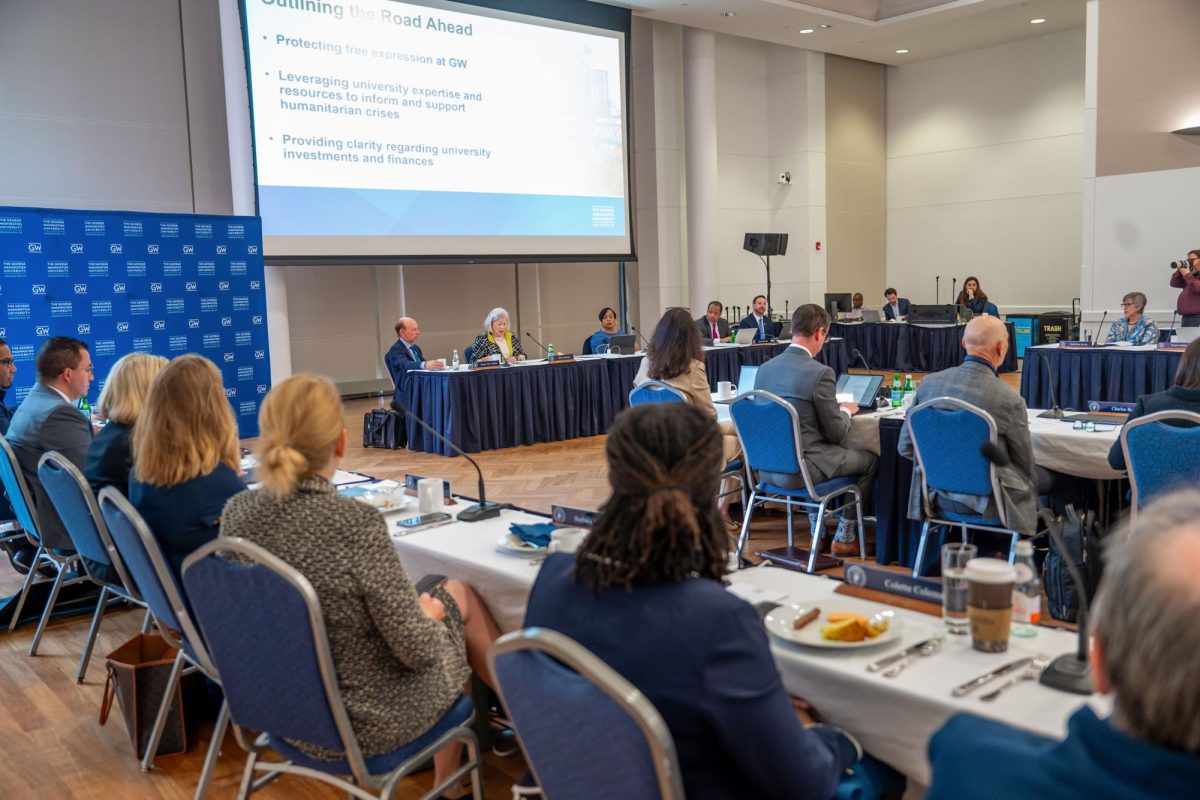After years of advocacy for a reformed dining plan, students said the newly announced dining halls set to open on campus next fall could enhance food accessibility and sense of community at GW.
Officials unveiled plans last week for the University’s new dining system that will feature three new dining halls with all-you-can-eat service next fall in Shenkman and Thurston halls as well as District House, shutting down most GWorld vendors operating in those buildings. Student leaders from the Student Association, Residence Hall Association and other student organizations collaborated with officials to devise the new system, which students said can break down food insecurity and barriers to dietary restrictions.
The current dining system, an open dining one that requires students to use dining cash to purchase food from grocery stores or restaurants, has faced years of criticism from members of the GW community for not providing students with enough money for food throughout the semester.
Kate Carpenter, the SA’s vice president, said she supports the new plan and hopes the dining system will be more accessible because of its diverse meal options and proximity to residence halls, and she hopes the revamped service will help tackle food insecurity at GW. A report from 2018 found nearly 40 percent of students faced food insecurity on campus, and officials increased GWorld dining cash balances for three consecutive years after many students said insufficient funds made meals more difficult to afford.
“They really saw a need to solve food insecurity, and even though not all students at GW struggle with food insecurity, one is one too many that struggles with food insecurity,” Carpenter said. “And so I think any measures that are taken to help that are important and are a must.”
Officials will start requiring students living on the Mount Vernon Campus this year to purchase the Pelham Plan, which costs $5,200 per year, according to GW’s dining website. The Pelham Plan grants students eight all-you-can-eat meals at Pelham Commons each week and an additional $3,240 in dining cash that can be used by the student at GWorld vendors.
Foggy Bottom residents spend $3,234 per year if they have a kitchen and $5,038 per year if they don’t have a kitchen, but students can also purchase the Pelham Plan, according to the website.
Carpenter said she agrees with officials who said the addition of new communal dining spaces could help foster community among students, who have spent five years without a dining hall in Foggy Bottom since the closure of the J Street Cafe in 2016.
“This dining hall will be a great way for not only us to gather together but also just build a community over food, over eating,” she said. “It’s just such an easy way to meet up with people and such an easy way to be able to meet new people that you wouldn’t typically meet.”
Junior Anna Weber, the SA’s vice president for campus operations, served on the University’s dining steering committee throughout the last academic year to advise the creation of the plan alongside a handful of student leaders, GW leadership and University staff. She said she worked on the new system with officials since the beginning of the planning process last fall, and building dining halls will help make campus a more welcoming environment.
“Having seen the entire process from start to finish, I have confidence that GW made the right decision bringing residential dining back to campus in terms of contracting and implementation,” Weber said in an email. “It’s well known that dining and sharing food is one of the best ways to create community, and I have hope that with the implementation of a hybrid residential and retail model, GW will start to feel like home more quickly for more students.”
Weber said the dining plan will still provide many options for students who are vegan or vegetarian or other students who face allergies. She added that students can also communicate with officials on an individual basis if additional dietary accommodations need to be met.
“Under this new plan, you should be easily able to find good food no matter if you’re vegan, eat kosher, are allergic to certain ingredients or have any other common dietary needs,” she said. “Additionally, I believe GW will be committing to working with students on a one-on-one basis if needed to ensure everyone has healthy, good food to eat that meets their needs.”
Officials emphasized that they will offer plenty of options for students with dietary restrictions, like those who are vegan or vegetarian, but some students said they worry that the new system will not have suitable options for their dietary needs.
Junior Elise Fuente said she has been looking forward to a change to the dining system since her freshman year at GW, because the open dining plan was not ideal for creating a positive community or managing time efficiently while cooking at home or walking to a restaurant. She said many students don’t know how to cook and that there wasn’t enough money on the plans to consistently eat out at restaurants.
“It didn’t seem like there was enough money just to go out and eat for every meal,” she said. “And nor should you have to, because I don’t really think that that’s the healthiest.”
Fuente said limited kitchen space in Thurston Hall her freshman year caused people she knew to deliberately skip meals because the area was too busy and eating out could be too expensive for the limited dining dollars given to students.
“They were consciously not eating too, because they felt like they didn’t have enough money on their plan, and so I kind of wish that there was some kind of system in place to help address those needs,” she said.
Freshman Maurianna Kowalski said the new plan could help her save money in the District, especially because restaurants in the Foggy Bottom area can be expensive. She said adding traditional dining halls and keeping various D.C. restaurants as GWorld vendors could provide a good combination of choice and affordability for students.
“I’ve heard that the Mount Vernon dining hall is pretty cheap in terms of how much money you have to use for your swipes,” she said. “So if something like that came to Foggy Bottom, I don’t think it could be too bad of an idea.”
Freshman Hannah Reynolds said she is a vegan with sensitive food needs, and the new plan makes her nervous because previous experiences with dining hall food at a boarding school didn’t meet her needs. She said she is worried that students may be forced to eat at dining halls that are not suitable for strict dietary restrictions, like sensitive stomach issues that she faces.
“Having dietary issues, cafeterias and cafeteria spaces sometimes aren’t the most friendly to that and allergies,” she said. “So I wonder how that will impact people.”








